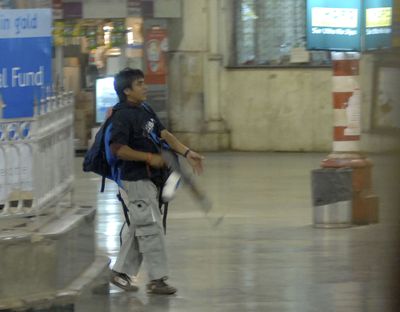Mumbai suspect at center of inquiry
Man trained by soldiers in Pakistan

MUMBAI – Of the 10 gunmen who carried out the attack in Mumbai last week, only one, Ajmal Qasab, was captured by the police. Shown in a grainy video clip with an assault rifle in hand as he tiptoed through a train station, his has become the face of the three-day assault that brought Mumbai to its knees and left at least 171 people dead. Since then, interrogations of Qasab have become the centerpiece of India’s probe into one of the worst terrorist attacks in the country in years.
“At first, Qasab resisted,” said Deven Bharti, a deputy police commissioner in Mumbai and one of the interrogators. “But after the first night, he began to reveal details.”
The portrait of Qasab that has emerged from the interrogations, Bharti said, is of a poor man who had received little formal education but who had undergone months of rigorous training to prepare for the killing spree last week.
At a news conference Tuesday, Mumbai’s police chief publicly aired some of the information culled from Qasab and other sources, giving the authorities’ first comprehensive account of an elaborate operation that they say began in Pakistan and ended with shootouts at sites across the city, including two luxury hotels and a Jewish center.
“What we know is that the ship in which they came started from Karachi in Pakistan. They hijacked a fishing trawler when they reached the international waters. Then they switched to a rubber dinghy when they reached near Mumbai waters,” said Hassan Ghafoor, the city police commissioner. “The person we have caught alive is certainly a Pakistani. They were all trained by ex-army officers, some for a year, some for more than a year.”
Ghafoor said the training took place in Pakistan, but he would not specify whether the trainers were from the Pakistani army. He also said the investigation so far has produced no evidence that the group had “immediate, local support” in India.
On the first night of the attack, Ghafoor said, the 10 assailants – armed with AK-47 assault rifles, ammunition and time bombs – split into groups of two and went in different directions. Qasab and an associate went to the station and began firing into the crowd, but they were shot at by the police as they tried to escape in a stolen vehicle. Qasab was injured in the arms, and his associate died on the spot.
Once in custody, Qasab was first taken to the hospital.
“He kept saying, ‘Please kill me, I do not want to live,’ ” said Kishore Bhatt, a hospital volunteer who was there that night. “He was on a stretcher about three to four feet away from me. He was injured. His face had no expression, but his voice sounded angry.”
Bharti, the interrogator, said that Qasab has told police that he is from a village called Faridkot, in Pakistan’s Punjab province, and that he dropped out of school after the fourth grade. His father owned a food stall. An acquaintance introduced Qasab to an outlawed group called the Lashkar-e-Taiba in 2005, and he later trained with the group in Muzaffarabad, the capital of Pakistan-controlled Kashmir.